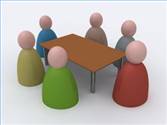Functions
 Class meetings promote and model social skills that are needed to be successful academically and socially. As we've noted, class meetings can serve a variety of functions:
Class meetings promote and model social skills that are needed to be successful academically and socially. As we've noted, class meetings can serve a variety of functions:- Connection
- Planning
- Goal-Setting
- Problem-solving
- Assessing/Evaluating
Morning Meeting
A 20-30 minute daily routine used to begin the school day in elementary and middle school classrooms. Usually they consist of:
- Greeting
- Sharing
- Group activity
- News and announcement
The skills and interactions used in planning lead to goal setting and agreements for the group. Goal setting examples would include:
- Fund raising
- Contests or competitions
- Grounds clean up
- Parental participation
Frequently, after setting goals, problem solving sessions are necessary. If there are conflicting wishes and needs a problem solving session might be used to clarify the issues and perspectives so that a consensus can be reached. For example, different cultural or religious perspectives might influence the type and kind of holiday celebration held. Or the class members might have to present their arguments for how they will spend a portion of the funds raised to enhance the classroom.
Problem solving can also use peer advice and opinion about group projects and group work.
The last step in this process is to assess whether or not the goals and needs have been met. Ask questions that encourage reflection, i.e., "Is this what you thought would happen?" or "How did this differ from what you expected?"
This kind of assessment is exemplified by having the class come together to discuss how a particular event or process has changed the individuals or class. Or the class could talk about a recent field trip with each person giving some feedback on what he or she learned or observed.
Licensed under the Creative Commons Attribution-NonCommercial-ShareAlike 2.5 License
Brought to you by creducation.org